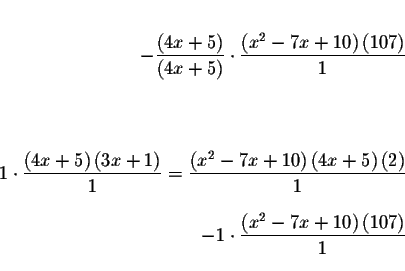 EQUATIONS INVOLVING FRACTIONS (RATIONAL EQUATIONS)
EQUATIONS INVOLVING FRACTIONS (RATIONAL EQUATIONS)
 EQUATIONS INVOLVING FRACTIONS (RATIONAL EQUATIONS)
EQUATIONS INVOLVING FRACTIONS (RATIONAL EQUATIONS)

Note:
If you would like an in-depth review of fractions, click on Fractions.
Solve for x in the following equation.
Example 3:

Recall that you cannot divide by zero. Therefore, we must eliminate any
values of x that will cause the denominator to have a value of zero. We
determine these values by setting the denominators equal to zero and solving
for x.

The only way a product equals zero is if at least one of the factors equals
zero.


If any of the solutions turn out to be either 2,
 , we
will discard them as extraneous solutions.
, we
will discard them as extraneous solutions.
Simplify the equation by subtracting 3 from both sides of the original
equation.

Simplify the equation by getting rid of the denominators. You do this by
multiplying both sides by the product of the denominators:
![]()





Rewrite the last equation in factored form.

The only way a product can equal zero is if at least one of the factors
equals zero.

Since
 is not a real number, the only real
solutions is x=15.
is not a real number, the only real
solutions is x=15.
Check the solution x=15 in the original equation for x. If the left side of the equation equals the right side of the equation after the substitution, you have found the correct answer.


Since the left side of the original equation is equal to the right side of the original equation after we substitute the value 15 for x, then x=15is a solution.
You can also check your answer by graphing ![]()
 .
.
This means that there is one real solution and the solution is x=15.
If you would like to test yourself by working some problems similar to this
example, click on Problem
If you would like to go back to the equation table of contents, click on
Contents

